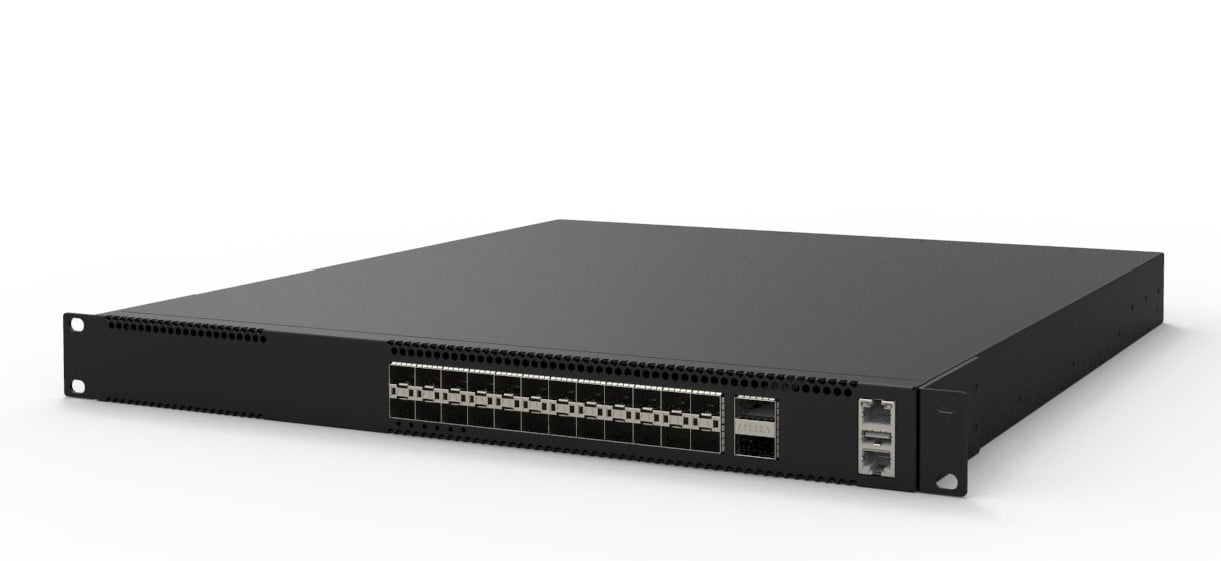CX202P-24Y-M-H
24-port 25G SFP28 Switch, 2 x 100G QSFP28/40G QSFP+L3 Core and Leaf Switch for Enterprise and Data Center, MLAG, VXLAN, BGP-EVPN Support
- 24-Port 25Gb SFP28/ SFP+ with 100Gb QSFP28 uplinks
- Core/Leaf(TOR) switch for enterprise networks and data center
- Support MC-LAG,VXLAN, QoS,BFD,IPSG,IPV6,etc
- A feature rich SONiC NOS Installed
Enterprise SONiC based 24 x 25Gb SFP28 SFP+, 2 x 100Gb QSFP28 /40Gb QSFP+, L3 Core/Leaf Switch for Enterprise and Data Center, Marvell Aldrin 3 Chip
Asterfusion 24-port ethernet switch CX202P-24Y-M-H has 24x25G SFP28/10G SFP+ and 2x100GQSFP28/40G QSFP+ ports, offering a total switching capacity of 800Gbps. This L3 ethernet switch is well-suited for enterprise layer 3 distribution and core networks. Additionally, it serves as a cost-effective top-of-rack switch for private clouds. Thanks to its commercial SONiC NOS-AsterNOS, the switch supports a variety of layer 2 and layer 3 functions, including routing protocols like OSPF and BGP, virtualization features like VXLAN and BGP-EVPN, as well as other capabilities such as MLAG and IPv6 support. Overall, this switch meets the requirements of next-generation Metro and enterprise networks.
Specifications
|
Features
Layer2/layer3 Features
- VLAN, MAC dynamic learning, MAC flapping detection, LLDP
- Voice VLAN, QinQ, STP, MSTP, Port mirroring based on RX and TX direction, Storm suppression, IPv4, IPv6 dual stack, Static ARP, Dynamic ARP,ARP Proxy, DHCPv4, v6, DHCP relay, NDP, Switch Virtual Interface (SVI)
- Routing protocols: OSPFv2, OSPFv3, BGP4, BGP4+, ISIS
- Policy routing based on 5-tuple, Equal Cost Multi-Path (ECMP), IGMPv1, IGMPv2
- Multicast VLAN, VRF, VXLAN, EVPN, EVPN VXLAN, GRE.
Comprehensive Network Security
- TACACS+802.1x and MAB authentication
- Security features
- Ingress and egress AC
- Layer 2 port isolation
- DHCPv4, v6 Snooping
- ND Snooping
- Dynamic ARP Inspection (DAI), IP Source Guard v4, v6.
High Reliability and Rich QOS
- Priority mapping based on 802.1p and DSCP, Traffic policing, Traffic shaping based on port or queue, Quality of Service, Queue scheduling based on PQ and DWRR algorithms, Static link aggregation, LACP, MCLAG, Load balancing based on SMAC.
- DMAC, SIP, DIP, SPORT, DPORT, and other HASH methods
- Uplink and downlink association (monitor-link)
- BFD: OSPF, BGP, IS-IS association.
Easy Network Maintenance
- SSH, telnet, console login, CLI style: Linux, Klish
- SNMPv1, SNMPv2, SNMPv3
- Zero Touch Provisioning (ZTP)
- Network Time Protocol (NTP)
- Syslog, Management
- Alarm information: temperature, power, fan, traffic LACPc overflow.
What’s in the box
- RJ45 Console Cable
- Preloaded Enterprise SONiC Distribution-AsterNOS
- 1RU Switch
Resources
Warranty
FAQ
Usually our AsterNOS runs on our own hardware (for Tofino and Teralynx), we provide either bare metal hardware, or hardware with AsterNOS, there is some amount of software cost if you choose H/W and S/W bundle, but this bundle should be more cost effective than today’s WhiteBox from one vendor and NOS from another vendor.



